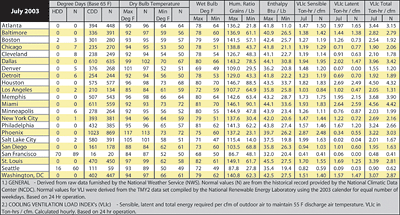

Figure 2 gives the VLI and degree day annual summary for 2002. The total cooling ventilation load index (VLI) is the total cooling energy (sensible plus latent) in ton-hrs/cfm of outside air that was required to maintain a constant 55˚F. The heating VLI is the sensible heating energy in therms/cfm of outside air that was required to maintain the same setpoint. The humidification VLI represents the gallons of water/cfm of outside air required to maintain 30% rh at 70˚ space temperature. All reported VLI data is based on 24/7/365 operation and all degree day data is based on a space neutral temperature of 65˚.
If you recall from last month’s report on ASHRAE design conditions, the 2002 cooling season was a real test for air conditioning systems and the heating season proved to be a little milder than normal, essentially countrywide. As can be expected, the degree day data tells us a similar story. Cooling degree days were higher in 2002 than in 2001 (and higher than normal) and heating degree days were lower for most of the country.
But as we discussed in the May report, if you are reviewing last year’s utility costs and your facility processes large amounts of outside air, it is always a good idea to look at VLI data. In Boston, for example, cooling degree days in 2002 were 18% higher than in 2001. So one could conclude that cooling costs were significantly higher because of the weather. However, the 2002 total cooling VLI for Boston was actually lower than in 2001, primarily because the latent component was 15% lower. As a result, for large Boston ventilation loads, it’s possible the impact of the 2002 weather was not all that significant, perhaps even resulting in a cost reduction compared to 2001.
The same considerations should be taken into account when looking at the heating season if a facility has large humidification loads. Denver is the perfect example. The heating degree days and the sensible heating VLI show that the weather impact on Denver heating bills for 2002 and 2001 was just about the same.
However, the humidification VLI data shows a 21% increase in humidification load compared to 2001. So a facility with large humidification loads in Denver may have actually seen a significant jump in 2002 heating costs even though the sensible heat related data shows otherwise.
Obviously, there are a lot of factors other than the weather that come into play when analyzing utility costs like differences in utility rates or changes in building loads, for example. But when trying to determine the impact of weather, many focus solely on degree days and latent loads are often ignored, sometimes resulting in inaccurate conclusions.


